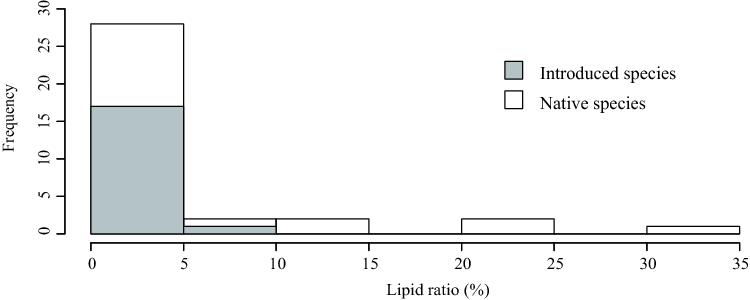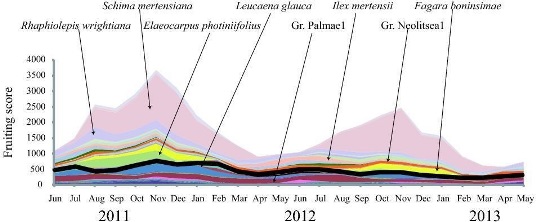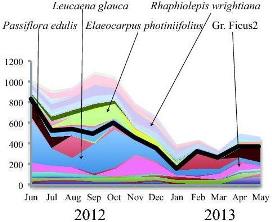Foraging strategy of the Red-headed Wood Pigeon in disturbed islands
LINKED PAPER
Seasonal and inter-island variation in the foraging strategy of the critically endangered Red-headed Wood Pigeon Columba janthina nitens in disturbed island habitats derived from high-throughput sequencing. Ando, H., Setsuko, S., Horikoshi, K., Suzuki, H., Umehara, S., Yamasaki, M., Hanya, G., Inoue-Murayama, M & Isagi, Y. 2016. Ibis: DOI: 10.1111/ibi.12345. View
Ninety-one percent of endangered Columbiformes live in islands (Walker, 2007). In disturbed oceanic island habitat, changes in seasonally available fruits due to deforestation and invasion by introduced plants may affect pigeon diet. Some pigeons may eat introduced plants as a complement to native food resources, or they may selectively choose introduced plants when these are high in terms of quantity and/or quality. In such situations, the removal of certain introduced plants may negatively impact the pigeon populations. For effective habitat conservation of island pigeons, it is necessary to understand their foraging strategies in disturbed habitats.
The Red-headed Wood Pigeon Columba janthina nitens is an endemic subspecies of the Ogasawara Islands, a chain of oceanic islands located 1,000 km south of the main island of Japan. Due to its restricted habitat and small population size, the Red-headed Wood Pigeon is listed as Critically Endangered on the Japanese Red List. Several introduced plants seriously disturb their forest habitats (Kachi, 2010, Kawakami, 2010) and thus it is suspected that the pigeons may depend on introduced plants for their food. However, their detailed diet composition and food selection are poorly understood.
With the development of DNA barcoding and next-generation sequencing techniques (Valentini et al., 2009a, Valentini et al., 2009b, Shokralla et al., 2012), faecal analysis using high-throughput sequencing (HTS) is now an accepted method in studies of animal diets (Pompanon et al., 2012). This comprehensive and non-invasive method may be useful for diet analysis of threatened species.
In this study, we estimated diet composition of the Red-headed Wood Pigeon and its seasonal and inter-island differences using HTS faecal analysis, identify the factors that influence food selection by the Pigeon and evaluate the importance of introduced plants as a food resource.
An analysis based on high-throughput sequencing (HTS) was undertaken on 627 faecal samples collected over 2 years from two island habitats: Chichijima and Hahajima. Food availability and the nutrient composition of the major fruits were also estimated.

Diet composition and food selection of the Red-headed Wood Pigeon
One hundred and twenty two plant species were detected from the faeces of the Red-headed Wood Pigeon. Planchonella and Neolitsea, which were detected at high frequencies over long periods of time in the Chichijima samples, appear to be the major food resources for the Pigeons on that island. Planchonella was also detected in the Hahajima samples, but Leucaena glauca and Morus australis were more frequently consumed. Although only appearing with high frequency at certain times, the number of sequence reads of Ficus was the largest on both the islands, indicating high consumption of this plant by the Pigeons.
Diet composition of the Pigeon was clearly different among seasons and between the two island habitats. According to the results of our models, Pigeons selected lipid-rich fruits in both islands, but other factors differed between islands, indicating the flexible change of food selection of the pigeons according to available food resources in each island.
Figure 2a (above and right) Change in the diet composition of the Red-headed Wood Pigeon and fruiting abundance. The scored fruiting abundance are shown for Chichijima (above) and for Hahajima (right). The plants that are shown under black lines are introduced species. (click on image for larger view)
Figure 2b (above and right) The relative frequencies of the sequence data from each month are shown for Chichijima (above) and for Hahajima (right). The plants that are shown under black lines are introduced species. The numbers in parentheses are the sample sizes for each month. (click on image for larger view)
Flexibility in diet composition and diversity appears to be an important strategy that island pigeons use to survive in restricted island habitats, which exhibit within- and among-year variations in food resource availability, as reported in previous studies (Oliveira et al., 2002, Emeny et al., 2009). In the case of the Red-headed Wood Pigeon, movement between the islands has been reported (Suzuki et al., 2006). The relationship between foraging strategy and inter-island movements of the Pigeons is unclear, but Pigeons may move among islands to search for food and change their food selection patterns based on the resource availability on each island. This may be a strategy for survival in isolated oceanic islands with limited habitat and food resources.
Significance of introduced plants as food resources for the Red-headed Wood Pigeon and management issues
Pigeons consumed introduced plants more frequently in Hahajima than in Chichijima. Frequency of consumption of introduced plants tended to increase when the abundance of native fruits decreased. Although the lipid ratio of introduced fruits was lower than that of native fruits, introduced plants may be important to complement lack of preferred native food resources.

The white and grey areas show the frequencies of native species and introduced species, respectively.
If introduced plants expand further, Red-headed Wood Pigeon may further increase their dependence on introduced fruits. The frequent use of low-quality, introduced fruits by the Pigeon may negatively impact reproduction, so eradication of introduced plants and restoration of native food plants may be important for long-term conservation of the species. However, the effect of introduced plant eradication on foraging of the Red-headed Wood Pigeon may differ between Chichijima and Hahajima. In Chichijima, positive impacts on foraging conditions may be expected by eradicating introduced plants, which may cause the recovery of preferable native food plants. However, the restoration of several native plants to compensate for the lack of food resources in early summer may be required. In Hahajima, where introduced fruits are consumed more frequently and food quantity is more important than specific foods, the rapid reduction in food resources for the Pigeons following the eradication of frequently consumed introduced plants may negatively impact foraging conditions. Thus, various native plants that provide fruits throughout the year should be simultaneously restored with the eradication of introduced plants.

The combination of comprehensive and objective HTS diet analysis with field data may aid in understanding foraging strategy of threatened bird species including interactions with introduced species. Such studies will inform appropriate planning for the conservation of oceanic island biodiversity.
References
Emeny, M. T., Powlesland, R. G., Henderson, I. M. & Fordham, R. A. 2009. Feeding ecology of kereru (Hemiphaga novaeseelandiae) in podocarp-hardwood forest, Whirinaki Forest Park. New Zealand Journal of Ecology. 33: 114–123. View
Kachi, N. 2010. Impacts of invasive alien species on native ecosystems on the Bonin Islands. In: Kawakami, K. & Okochi I. (eds)Restoring the Oceanic Island Ecosystem. Tokyo: Springer, pp. 11-14. View
Kawakami, K. 2010. What’s the Bonin Islands? In: Kawakami, K. & Okochi I. (eds) Restoring the Oceanic Island Ecosystem. Tokyo: Springer, pp. 3-7. View
Oliveira, P., Marrero, P. & Nogales, M. 2002. Diet of the endemic Madeira Laurel Pigeon and fruit resource availability: a study using microhistological analyses. The Condor. 104: 811–822. View
Pompanon, F., Deagle, B. E., Symondson, W. O., Brown, D. S., Jarman, S. N. & Taberlet, P. 2012. Who is eating what: diet assessment using next generation sequencing. Molecular Ecology. 21: 1931-1950. View
Shokralla, S., Spall, J. L., Gibson, J. F. & Hajibabaei, M. 2012. Next-generation sequencing technologies for environmental DNA research. Molecular Ecology. 21: 1794-1805. View
Suzuki, H., Shibazaki, F., Hoshi, Y., Suzuki, N., Horikoshi, K., Shoji, M., Shoji, M., Sakairi, Y. & Takano, H. 2006. Inter-island movement of Columba janthina nitens in the Ogasawara Islands, Japan. Strix. 24: 99-107.
Valentini, A., Miquel, C., Nawaz, M. A., Bellemain, E., Coissac, E., Pompanon, F., Gielly, L., Cruaud, C., Nascetti, G., Wincker, P., Swenson, J. E. & Taberlet, P. 2009a. New perspectives in diet analysis based on DNA barcoding and parallel pyrosequencing: the trnL approach. Molecular Ecology Resources. 9: 51-60. View
Valentini, A., Pompanon, F. & Taberlet, P. 2009b. DNA barcoding for ecologists. Trends in Ecology & Evolution. 24: 110-117. View
Walker, J. S. 2007. Geographical patterns of threat among pigeons and doves (Columbidae). Oryx. 41: 289-299. View
Image credit
Featured image: Red-headed Wood Pigeon Columba janthina nitens © Haruko Ando
If you want to write about your research in #theBOUblog, then please see here.









